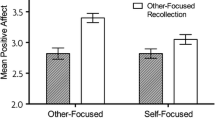Abstract
Guided by Jones and Davis’ (1965) theory of correspondent inferences, an experiment was conducted to explore the conditions under which prosocial behavior is attributed to altruism. Some 14 vignettes were constructed to vary aspects of five general dimensions believed to underlie perceptions of altruistic behavior: Benefits or costs to the actor or the actor’s close kin; benefits to the recipient of help; behavior extending beyond usual helping roles and norms; intentionality of helping; and planful versus spontaneous helping. A total of 164 respondents evaluated the actor and his or her behavior on scales measuring altruism and praiseworthiness. As hypothesized, the first four dimensions consistently predicted judgments of altruism, while the fifth did not. Strengths and shortcomings of the vignette approach are discussed, as are directions for subsequent research.
Similar content being viewed by others
References
Baron, R.A. (1977).Human aggression. New York: Plenum.
Batson, C.D. (1987). Prosocial motivation: is it ever truly altruistic? In L. Berkowitz (Ed.),Advances in experimental social psychology (Vol. 20). New York: Academic Press.
Batson, C.D., & Coke, J.S. (1981). Empathy: a source of altruistic motivation for helping? In J.P. Rushton & R.M. Sorrentino (Eds.),Altruism and helping behavior: Social, personality, and developmental perspectives. Hillsdale, N.J.: Erlbaum.
Bem, D. (1972). Self-perception theory. In L. Berkowitz (Ed.),Advances in experimental social psychology (Vol. 6). New York: Academic Press.
Brehm, J.W. (1972).Responses to loss of freedom: A theory of psychological reactance. Morristown, N.J.: General Learning Press.
Brown, R.C. Jr., Tedeschi, J.T. (1976). Determinants of perceived aggression.Journal of Social Psychology, 100, 77–87.
Buss, A.H. (1961).The psychology of aggression. New York: Wiley.
Cialdini, R.B., Schaller, M., Houlihan, D., Arps, K., Fultz, J., & Beaman, A.L. (1987). Empathy-based helping: is it selflessly or selfishly motivated?Journal of Personality and Social Psychology, 52, 749–758.
Clark, R.D. III, & Word, L.E. (1972). Why don’t bystanders help? Because of ambiguity.Journal of Personality and Social Psychology, 24, 392–400.
Darley, J.H., Teger, A.E., & Lewis, L.D. (1973). Do groups always inhibit individuals’ responses to potential emergencies?Journal of Personality and Social Psychology, 8, 377–383.
Dawkins, R. (1978).The selfish gene. New York: Oxford University Press.
Dovidio, J.F. (1984). Helping behavior and altruism: An empirical and conceptual overview. In L. Berkowitz (Ed.),Advances in experimental social psychology (Vol. 17). New York: Academic Press.
Festinger, L. (1957).A theory of cognitive dissonance. Evanston, Ill.: Row, Peterson.
Goranson, R.E., & Berkowitz, L. (1966). Reciprocity and responsibility reactions to prior help.Journal of Personality and Social Psychology, 3, 227–232.
Greenberg, M.S., & Frisch, D.M. (1972). Effect of intentionality on willingness to reciprocate a favor.Journal of Experimental Social Psychology, 8, 99–111.
Heider, F. (1958).The psychology of interpersonal relations. New York: Wiley.
Hornstein, H. (1970). The influence of social models on helping. In J. Macaulay & L. Berkowitz (Eds.),Altruism and helping behavior. New York: Academic Press.
Isen, A.M., & Levin, P.F. (1972). Effect of feeling good on helping: Cookies and kindness.Journal of Personality and Social Psychology, 21, 384–388.
Jones, E.E., & Davis, K.E. (1965). From acts to dispositions: the attribution process in person perception. In L. Berkowitz (Ed.),Advances in experimental social psychology (Vol. 2). New York: Academic Press.
Jones, E.E., Davis, K.E., & Gergen, K.J. (1961). Role playing variations and their informational value for person perception.Journal of Abnormal and Social Psychology, 63, 302–310.
Jones, E.E., & Harris, V.A. (1967). The attribution of attitudes.Journal of Experimental Social Psychology, 3, 1–24.
Krebs, D.L., & Miller, D.T. (1985). Altruism and aggression. In G. Lindzey & E. Aronson (Eds.),Handbook of social psychology, (Vol. 2) (3rd ed.), New York: Random House.
Latane, B.S., Nida, A., & Wilson, D.W. (1981). The effects of group size on helping behavior. In J.P. Rushton & R.M. Sorrentino (Eds.),Altruism and helping behavior: Social, personality, and developmental perspectives. Hillsdale, N.J.: Erlbaum.
London, P. (1970). The rescuers: motivational hypotheses about Christians who saved Jews from the Nazis. In J. Macaulay & L. Berkowitz (Eds.),Altruism and helping behavior. New York: Academic Press.
Macaulay, J., & Berkowitz, L. (1970).Altruism and helping behavior. New York: Academic Press.
Rachels, J. (1987).The elements of moral philosophy. New York: Random House.
Rushton, J.P. (1982). Altruism and society: a social learning perspective.Ethics, 92, 425–446.
Severy, L.J. (1974). Comments and rejoinders.Journal of Social Issues, 30 189–198.
Staub, E. (1978).Positive social behavior and morality, (Vol. 1). New York: Academic Press.
Swap, W.C. (in press). Perceptions of aggression: a multivariate approach.Social and Behavioral Science Documents.
Tesser, A., Gatewood, R., & Driver, M.S. (1968). Some determinants of gratitude.Journal of Personaltiy and Social Psychology, 38, 291–300.
Thompson, V., Stroebe, W., & Schopler, J. (1971). Some situational determinants of the motives attributed to the person who performs a helping act.Journal of Personality, 39, 460–472.
Author information
Authors and Affiliations
Rights and permissions
About this article
Cite this article
Swap, W.C. When prosocial behavior becomes altruistic: An attributional analysis. Current Psychology 10, 49–64 (1991). https://doi.org/10.1007/BF02686780
Accepted:
Issue Date:
DOI: https://doi.org/10.1007/BF02686780




